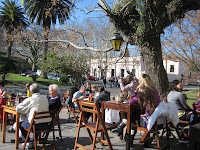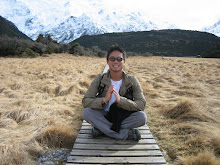Here's a short position paper I wrote for SFO on increasing SFO's load capacity and improving operational efficiency.
I. Introduction
The Airport Commission’s current approaches to maximize airport efficiency may not necessarily keep pace with meeting the airport’s long-term capacity needs. According to the FAA’s 2007 Capacity Needs report, SFO will fall short of needed capacity by 2025 even after planned improvements are implemented.
[1] Several factors constraining airport capacity include the financial and environmental costs associated with increasing SFO’s physical size.
[2] The issue, therefore, is how to significantly increase SFO’s capacity without physically increasing the airport size.
This paper explores several methods to increase SFO’s capacity based on technologically, financially, and logistically grounded solutions.
II. Technology Based Solutions
The implementation of new aviation technology to maximize both air and ground traffic efficiency will increase overall airport capacity. The on-going advances in aviation technology, such as FAA’s next-generation air transportation system (“NextGen”), has the potential of maximizing air-side capacity by “reduc[ing] the separation between aircraft and permit more efficient routing of planes.”
[3] For example, a wake turbulence management system reduces the in-trail and vertical spacing between aircrafts to increase overall air-side capacity while ensuring safety from wake turbulence. Studies have shown that a one mile reduction of aircraft spacing can boost runway capacity by 20 percent.
[4] Wake turbulence management will also allow SFO to more efficiently use its parallel runways.
Technology can also be harnessed to maximize ground traffic efficiency. The Surface Area Movement Management system (“SAMM”) increases land-side efficiency and air-side capacity by coordinating ground traffic “to minimize distances, hold times, and separation between aircraft.”
[5] The Total Airport Management system (“TAMS”), which is currently used at Kuala Lumpur International Airport, increases operational efficiency by connecting ground support, aircraft suppliers, and air traffic control through an integrated computer system.
[6] The free flow of electronic information and instant communication between various airport facilities increases overall capacity through operational efficiency.
[7]A combination of NextGen, a wake turbulence management system, SAMM and TAMS has the potential to optimally increase SFO’s overall air-side and land-side capacity.
III. Financially Based Solutions
To complement SFO’s current practice of congestion pricing, the Airport commission should also consider discounting landing and departure fees for off-peak hours. Offering discounted landing and departure fees during off-peak hours may further induce some aircraft operators, such as operators of cargo and private planes, to use SFO during off-peak hours. A combination of congestion and discount pricing, therefore, has the potential to increase SFO’s operational capacity in two ways.
First, such market-based landing and departure fees, as determined by demand and other market forces, are more effective than weight-based fees because it offers aircraft operators a financial incentive to increase load capacity to maximize per passenger revenue during peak hour usage.
[8] Second, the financial incentive will also induce aircraft operators to favor airport use during off-peak hours. Thus, aircraft operators may want to shift some or all of their operations to off-peak hours. Perhaps the long-term goal is to make each hour at SFO a peak hour of operation in terms of optimal load capacity and maximized frequency of arrivals and landings. This goal will allow SFO to achieve optimal capacity.
IV. OTHER CONSIDERATIONS
The coordination of technologically and financially based solutions across Bay Area airports will ultimately increase SFO’s capacity through the following recommendations. First, integrating advanced aviation technology throughout Bay Area airports will optimize shared airspace and thereby increase air-side and land-side efficiency at each airport. Second, Bay Area airports should coordinate and standardize congestion and discount pricing in order to maximize pricing utility.
[9] For example, if only SFO implemented congestion then aircraft operators would simply divert their operations to SJC and OAK. However, congestion in the shared airspace will remain. A unified pricing system throughout the Bay Area airports will maximize the current and proposed pricing options.
A final consideration is to link SFO and OAK with a non-stop express BART on the existing rail system. This proposal requires connecting OAK’s terminal to BART. The system trims regional and smaller aircraft service into SFO by redirecting those passengers into OAK. This allows SFO to focus on higher capacity aircraft which directly increases SFO’s capacity.
V. CONCLUSION
A combination of technologically, financially, and logistically based solutions across the Bay Area airports will ultimately increase SFO’s air-side and land-side capacity.
References:
[1] The Mitre Corporation, Capacity Needs in the National Airspace System, 2007-2025 (Washington, D.C.: Federal Aviation Administration, May 2007).
[2] Marisa Lagos, A place to land: FAA study says Bay Area airports must expand to meet demand, S.F. Chron., May 16, 2007, available at
http://www.sfgate.com/cgi-bin/article.cgi?f=/c/a/2007/05/16/BUGVAPRFU31.DTL&%20hw=San+Francisco+International+Airport+expansion&sn=001&sc=1000.
[3] Viggo Butler, Increasing Airport Capacity without Increasing Airport Size, p. 2 (Reason Foundation, Policy Study 368, 2008), available at
http://www.reason.org/ps368.pdf.
[4] Butler, p. 16-17.
[5] Id. at p. 14.
[6] Kuala Lumpur International Airport, http://www.klia.com.my/index.php?WebsiteId= 13&ch=1&pg=23&ac=9 (last visited April 20, 2008).
[7] Dr. Henning Harmann, Final Report of Preliminary Study Total Airport Management, p.21-22 (Institute of Flight Guidance, Nov. 2001) available at:
http://www.eurocontrol.int/care-innov/public/standard_page/studies 2001_dlr.html.
[8] See Robert W. Poole, Jr. and Ben Dachis, New York Airport Pricing: Frequently Asked Questions, (Reason Foundation, Policy Study 266, 2008).
[9] Id. at p. 1.
 We spent this past weekend in Nick's hometown of Chicago for his b-day! This is my third visit to Chicago . . . reconfirming just how this city ROCKS!
We spent this past weekend in Nick's hometown of Chicago for his b-day! This is my third visit to Chicago . . . reconfirming just how this city ROCKS!
 There's one more in the gang...but he's reclusive.
There's one more in the gang...but he's reclusive. Sears Tower! Notice the 4 stars on the Chicago flag. A fifth star will be added if Chicago wins its Olympic bid. Also notice the baby . . . there's always a baby around Nick.
Sears Tower! Notice the 4 stars on the Chicago flag. A fifth star will be added if Chicago wins its Olympic bid. Also notice the baby . . . there's always a baby around Nick. 






























